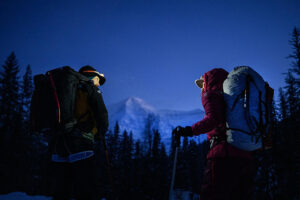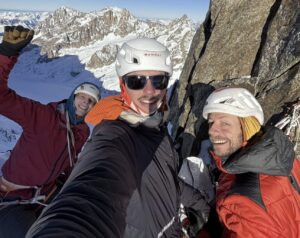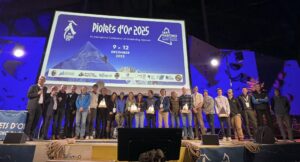The international climbing community is starting to comprehend the great feat that Benjamin Vedrines and Leo Billon achieved on The Drus, the Droites, and the Grandes Jorasses.
The pair chain-climbed three major big wall routes on the most difficult faces in the Alps. They did so in winter, onsight, all free climbing in one non-stop push without bivouacs on the wall, in just three days.
It included bagging the first one-day ascents of both the Petit Dru’s Voie des Guides (850m, ED+, M8+) and No Siesta on the Grandes Jorasses (1,100m, ED+, WI6 M8 XR) in 10 and 12 hours respectively.
In between, they climbed the Droite’s Rhem-Vimal (1,000 m, M7/M8) in 7 hours, 4 minutes.
Already with his mind on his next project, Vedrines had time to comment about the feat in an exclusive interview with ExplorersWeb.
Legendary faces
While climbers around the world are familiar with these three legendary north faces of the Mont Blanc region, there are still several ways to use these old standards to raise alpine excellence, as Vedrines and Billon demonstrated.

On the north face of Les Droites. Photo: Seb Montaz
Just climbing one of them is a dream for any skilled alpinist. From that point, the merits increase depending on the route, speed, style, and conditions. The two young French mountain guides did them in winter, on highly difficult routes, completely free, with no bivouacs. Only really excellent climbers can hope to achieve that goal of a lifetime.
The climbers had the project in mind for years, and selected their approach carefully.
Experience over specific training
“We did not have a specific preparation for the trilogy, but for several years, we have been careful to choose one or more projects in our winter and summer seasons…in order to be conditioned and mentally and physically prepared,” explained Vedrines.

Approaching the north face of the Drus (in background) on skis. Photo courtesy of Benjamine Vedrines
Instead of specific training, the two climbers meticulously built up their endurance and their rock climbing skills.
Vedrines had done some dry-tooling sessions, but Leo Billon had not used piolets on rock for a year when they faced the mixed terrain of these north faces.
“The key to projects like this is experience,” Vedrines said. “We both acquired that expertise by carrying out several projects together. Also, our motivation was enormous, because we knew that it represented a new stage in our mountaineering careers.”

The Route des Guides on the North Face of Petit Dru. Photo courtesy of Benjamine Vedrines
Finally, Vedrines admits that both Billon and himself had plenty of the essential element of time. “We had a lot of time to train, a lot of time to prepare, and time to wait for the right weather. It’s so rare to have all the planets aligned.”
Routes onsight
The Alps are Vedrines and Billon’s usual playground. They know how to move there, are familiar with the weather and conditions, and know what equipment to bring. Otherwise, they did their chosen routes completely onsight.
“We had no idea about the routes we were embarking on,” Vedrines said. Yet they did the two first routes as if they had been there a thousand times. The descents, with long rappels, were also uneventful.

Unstable terrain on the north face of the Droites. Photo courtesy of Benjamin Vedrines
Things changed as they started the infamous No Siesta on the North Face of the Grandes Jorasses. The climbers lost their way up shortly after starting up the face. Recalls Vedrines:
We misinterpreted a photo shared by a friend the day before, and we went too far to the left. I went back down. Hoping to get off the face before darkness fell, Leo tried to take another line instead, the Bonatti route. But the rock was not in good condition at all, and I found it wiser to try the route on the original No Siesta project again, right at the point where we had missed the way.
Leo [Billon] finally found the right passage, by forcing himself up a very technical section. This cost us two hours and was why we reached the summit in the dark. It was really very cold and we did not have gear for a bivouac, so the only way was up.

Leo Billon about to exit the North Face of the Grandes Jorasses at night. Photo: Benjamin Vedrines
Dire moments
As Vedrines remarks, the climbers were able to afford the extra time spent at the Grandes Jorasses only because they completed the two previous routes so quickly and efficiently.
“If we took just one more hour on the North Face of the Drus, it would have been complicated to continue the next day with another North Face. Likewise, on the North Face of the Droites, if we had taken two hours more, it would have been complicated to continue the next day with the Grandes Jorasses.”

Between rotten rock and the void on the North Face of the Grandes Jorasses, somewhere between the Bonatti and the No Siesta routes. Photo: Benjamin Vedrines
There were some dire moments when the guys got lost on No Siesta. “I admit I was not sure whether we were going to manage to get out. Rescue in that place would be difficult because rappeling down the face from above us would have been extremely complex,” Vedrines said.
“Let’s say that, at a certain moment, we got somehow stuck, with a very dry Bonatti route on the left, on very poor, rotten rock, and a passage to the right where we had difficulty finding the way out. We were tired from the previous two days and had to gather all our lucidity to make the right choice.”
A lifetime project
Vedrines admits the trilogy is “a lifetime project, given all the skills necessary to complete it.” Interestingly, they had not even planned it for this winter. “I planned to do it later because I wanted to focus on another [solo] project,” said Vedrines. “But I couldn’t resist the call of my rope partner…and I followed the instinct that told me this was the right moment and Leo was the right partner.”

Vedrines (left) and Billon congratulate each other on the summit of the Petit Dru. Photo: Benjamin Vedrines
Needless to say, Vedrines couldn’t be happier with the decision he made. “We make a unique team, almost a sacred pair. It would have been such a shame to miss the opportunity!”
The alpine trilogy is enough to fill the year of any professional climber, but we’re still in February and Benjamine Vedrines is not any climber. We’ll publish a separate story tomorrow about his plans for the near future.
Meanwhile, have a look at Vedrines’ stage-by-stage Instagram posts about the trilogy:






